Abstract: The paper attempts to study the changes in the labour force in India during the last few decades. The participation of women in economic activity in rural and urban areas is also subjected to analysis. The paper concludes with suggestions for enhancing women’s work participation rate.
Keywords: Manpower and Female Workforce, Male/Female work participation, Industrial distribution of women workers, Primary/ Non-primary Sector, Socio-Economic Development
The manpower of a nation is the totality of persons who could produce the goods and services if there were a demand for their labours and they desired to participate in such activity. The economically active population, sometimes also called the working force, is that part of the manpower which actually engages, or attempts to engage, in the production of economic goods and services (UN, 1976).
An important economic characteristic of the population of a country is the size and quality of its work force. The number and quality of work and regularity of employment of the economically active population determine the economic and social development attained by that nation. In other words, the important aspect of the structure of economy is closely related to the level of the country’s economic development and productive efficiency.
The economic and social development of a nation depends on the number of persons who are economically active and the quality of their work. Labour force participation rates are useful for an understanding of the extent to which women, children and the aged participate in economic activity. Several questions can be answered through an analysis of labour force statistics from the point of view of social welfare. And such studies provide the base on which national plans for social and economic development may be formulated and are therefore, considered important for policy makers and planners (Asha. A. Bhende, 1985).
The importance of the labour force is obvious, especially for developing countries where unemployment is a major problem. As economic development and industrialization advance, it is generally expected that there is more scope for specialization and division of labour. Along with the study of general trends regarding labour force participation, the study of the economic activity of certain sections of the population also receives attention. Economic activity of females and of children is a subject of special importance for most of the developing agricultural countries like India (Sumathi Kulkarni, 1981).
Labour force participation of women
Women’s work outside the home has become a necessity for society as well as for women. Most families prefer the woman to work so that family’s class status will go up which in the long run carves a unique niche for that particular family in the society. In developing countries like India where traditions are deep rooted in various aspects of life, employment for women is considered only as a peripheral phenomenon. The main duty of the woman is still wifing and mothering. Studies in India reveal that women’s roles are still in the fold of tradition as society expects women to be more familial and not societal. Men are considered as societal and therefore there is no concept of ‘house-husband’ whereas women, a familial category, is never societal or society never permits her to be in the main stream. As long as this distinction stays in the society, woman will mainly be a house wife (Thara Bahi, 2000).
Though scientists in the field always mention the woman in the Indian context or Indian perspective, they never distinguished her in general and specific terms. A number of studies on women’s issues were conducted in the last three decades and analysis of these works proves that there are innumerable categories of women in India. To make it more clear, issue specific analysis are related to the various groups of women in different ways. In the first place, or issues like education and occupation, rural and urban women show sharp contrast. Our rural women are not the same as urban women, as rural culture and rural society may be at times contradictory to each other.
In most countries women represent that component of the labour force whose participation is the most sensitive to economic as well as social development. Wide differences are noticed in the industrial sector of female labour between countries and even within countries, according to the nature of economic development of the economy. In most developing countries the majority of women are found working in the agricultural sector with more females in the tertiary sector compared to secondary sector.
This paper is an attempt to understand the changes in the participation in economic activity by women in the major states of India and a specific analysis is made for Kerala also. Stress is given to study the sex pattern of participation in economic activity separately for rural and urban areas during the last three decades. Inequality between the sexes gets special attention in this paper. The given rate of economic activity other than that of cultivators and agricultural labourers in Kerala, is also analysed for rural and urban areas.
The study is based on the census data on the size and industrial distribution of working force. Data on workers in the major states of India are taken from various census reports of 1961 to 2001. Comparison of workers in different census periods became a problem due to variations in the concept and definition of workers in each census during 1981-2001 period. Main and marginal workers are taken together as workforce for the purpose of this study.
The most common measure of labour force, the crude activity rate, is used to make comparison. The crude activity rate is the percentage of persons economically active to the total population. The variations in definitions and operational procedures that most often affect measures of economic activity have their greatest impact on figures for women, because women’s attachment to the labour force is often marginal and intermittent. For men, the rates are less subject to temporary or spurious variation than rates for women and comparison of rates for men are valued (United Nations, 1976). The male-female difference in the participation is calculated to find the gap between the two sexes. The dissimilarity index is also used in certain places to find the equality between male and female activity rates, which is calculated using the formula,
 |
Labour force in India
The pattern of employment distribution of Indian workers is one of marked concentration in agriculture with a considerably smaller fraction involved in industry. Since labour force participation rates tend, typically, to be lower for both males and females in urban areas than in rural areas, the historical impact of urbanization on crude activity rates has been negative. The failure of structural change in employment to accompany urbanization can be traced to the fact that the growth of modern industry in towns and cities dealt a blow to the rural household industry. With changing technology and scale of production there was a shift in the location of industry from rural to urban centres, specially large metropolitan cities. These changes were unfavourable to women’s participation in work.
According to the report of the committee on the status of women in India (1974) the number of female employees in the categories of professional, technical and related work and primary and middle school teachers has been continuously rising since 1960. In post independence India we had a series of laws passed for the upliftment of women. The constitutional recognition of equal status for women and progressive enactments have undoubtedly empowered Indian women with judicial equality. But the principles of equality enshrined in the constitution of India are far from reality.
Today the situation has changed and there are remarkable changes in the attitude of women, particularly employed, towards the natural superiority of men. Many girls are getting opportunities of entering the portals of higher education and they are working in non-traditional jobs like men. Even though women workers have increasingly taken to industrial work, both skilled and semi-skilled, their participation in the productive pursuits of the country is very low, when compared to men. Another noteworthy feature is that there has been a general decline in the proportion of female working population to total female population.
The female labour force participation rate in India is not only low, but also has remained near stagnant over the past several decades. Moreover, there still exists a large difference between the work participation rates of males and females, which is an important aspect of gender inequality. The data on work force provided in the reports of the successive rounds of National Sample Survey (NSS) clearly point out the trend of increasing casualisation of the workforce, the incidence of which is more severe among women than among men. The trend in the participation rate obtained from census data consequently differed between sexes as is evident from the following Table1
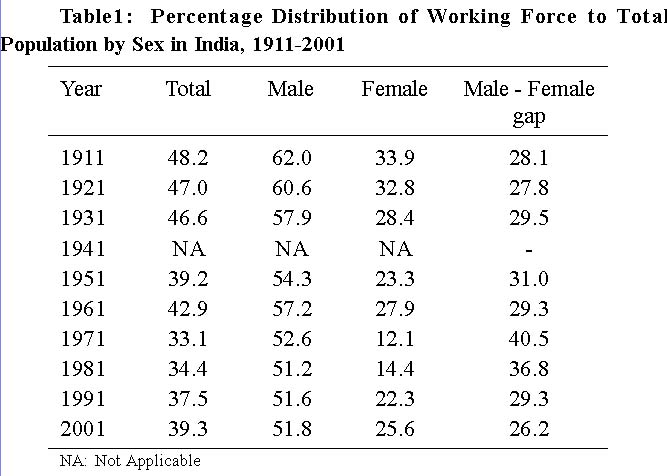 |
It can be observed from the data in Table 1 that the percentage of working population to total population has been gradually on the decline both among males and females during the last ninety years. There were 180.4 million workers constituting nearly 33.1 percent of the total population in 1971 which increased to 34.4 percent in 1981. According to 2001 census, about 39.3 percent of the population of the country are engaged in some economic activity. This is an increase of about 1.8 percentage points over the corresponding figure as per the 1991 census. Thus the share of workers in India has increased by less than 2 percent during 1991-2001. This increase in the share of workers has brought down the economic dependency ratio in India.
Women working population came down from 33.9 percent in 1911 to 23.3 percent in 1951. After 1951, it rose to 27.9 in 1961 and slumped to 12.1 percent in 1971 and 14.4 percent in 1981. And in 1991, the work participation rate of females steadily rose to 22.3 percent and again shows an increase to 25.6 percent in 2001 census. This is only less than half of that of the percentage of males in the same period. Anyway it is a fact that women workers always formed a small proportion of the population.
The percentage of male working population to total population was 57.2 in 1961. It has come down to 52.6 in 1971 and 51.2 in 1981. The rate is almost the same in 1991 and 2001 with a slight increase in each year. The share of males among the workers has been reducing in the country since 1971 while the female share is on the rise. In 1971, 80.3 percent of the working population was males while in 1991 this was only 71.3 percent. Thus the female share of workers has increased by about 9 percentage points during this period, and again an increase of 9 percentage from 1991 to 2001.
The country has 2.5 male workers for every female worker as per the 1991 census and it reduced to 2.2 male workers for one female worker as per 2001 census. This is almost same as in the position of 1961 when the ratio was only 2.2, the ratio has been coming down as compared to the position of 1971. Thus the gap between the shares of male and female workers has reduced considerably between 1971 and 1991. the maximum gap in the male-female rates was seen in the year 1971 where it was 40.5 percent and it was least in 2001 census. All of these observations show that the difference in the male-female participation rates narrowed and so female work force increased from the period of 1971 to 2001. Rural – Urban Share of Workers
Studies of the rural Indian female participation rates and its variation in the states of India found that the rate of economic activity was high in the rural areas when compared to the urban areas. Work participation rate in the rural and urban areas of males and females in India is given in Table 2.
About 40 percent of the population of rural areas in the country were in the labour force in 1991. This share has increased regularly both in rural and urban areas since 1971. Compared to the rates in 1981, the increase is only marginal. As per 2001 census about 42 percent of the rural population and 32 percent of the urban population are workers. In both areas the increase is by 2 percentage points over the position of 1991. The gap between the shares of male and female workers has also narrowed down during 1971-2001 period. And this gap is very high in the urban areas and it remains almost in the same position from 1971 to 2001. But the gap in rural areas become narrowed and reached the level below that of the total population in 2001.
 |
In 1991, the country had about 2.5 male workers per female worker while in the rural and urban areas the values were 2.1 and 6.0 respectively. They have come down to 2.2, 1.8 and 4.9 respectively in 2001. Therefore the gap in the male-female participation rates in India is due to the wide gap that existed in the urban areas. Inequality between the male and female participation rates can be reduced only by reducing the male-female gap in urban areas or by increasing the participation of urban females.
Economic Activity in the Indian States
The work participation rates of both men and women declined during the decades from 1901 to 1971, in all the states. The trends have however, reversed to some extent since 1971. The share of males among the workers has been reducing in the states since 1971 while the female share is on the rise, after 1971. The 1971 census does not give the break-up for main workers and marginal workers. Hence in order to present comparable data, the following tables (Tables 3, 4 and 5) give the percentage of workers from 1981 to 2001 for the major Indian states. A uniform pattern of decline in female work participation rate was obtained in the states during the period. Considerable variations are seen between the states with regard to their economic activities in the 1981-2001 period.
Table 3 gives the percentage of workers for census years of 1981 to 2001, for the major states of India. Female work participation rate was highest in the state of Andhra Pradesh during the entire period. And the lowest female participation rate was in Punjab in 1981 and 1991 and it was in Kerala in 2001. Male participation rate also was lowest in Kerala in 1981 and 1991. The highest male participation rate was seen in the state of Tamil Nadu in 1991 and 2001. It was so Andhra Pradesh in 1981.
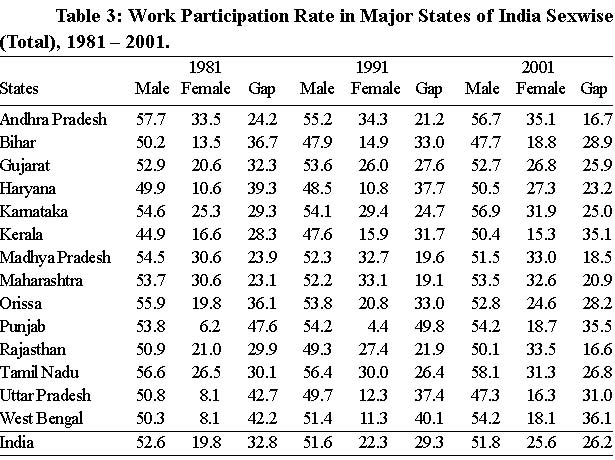 |
The male-female gap in rates gives a different picture. The gap is lowest in the state of Maharashtra and highest in Punjab according to 1981 and 1991 census. In 2001 the male-female difference in work participation was lowest in Rajasthan, where the female participation rate has steadily increased from 1991 to 2001. And the highest gap was noticed in West Bengal in 2001. The gap in male-female participation rates shows a declining trend from year to year in most of the states. Two states namely Karnataka and Maharashtra have an increase in the male-female gap during 1991-2001 period. Kerala is the only state where the gap was constantly increasing from 1981, and attained almost the highest level in 2001. In terms of Human Development Index, Kerala ranks first among Indian states and has the second lowest gender disparity also. But the development of women in economic activity is not at par with this situation.
Work participation rate in the rural areas of Indian states is presented in Table 4. In the case of male participation, the maximum rate was obtained in the rural areas of Andhra Pradesh in 1981, and in 1991 and 2001, this is in Tamil Nadu. The lowest male participation rate was always obtained in the rural areas of Kerala. In the case of female participation rate, the rural areas of Maharashtra is in the highest position and it was lowest in Punjab in 1981 and 1991. Kerala has the lowest female participation rate in rural areas also according to 2001 census and so attained the highest male-female gap. The lowest gap in male-female rate was obtained in Maharashtra where the female participation rate is highest among the states in all the periods considered. This gap is always declining from year to year in almost all the states. The exceptions are Kerala and Punjab. In Punjab the gap increased in 1981-91 period and then showed a decline in 2001. But in the case of Kerala, the male-female difference is increasing from period to period in the rural areas. And so the equality of rural females became less and less in the economic activity.
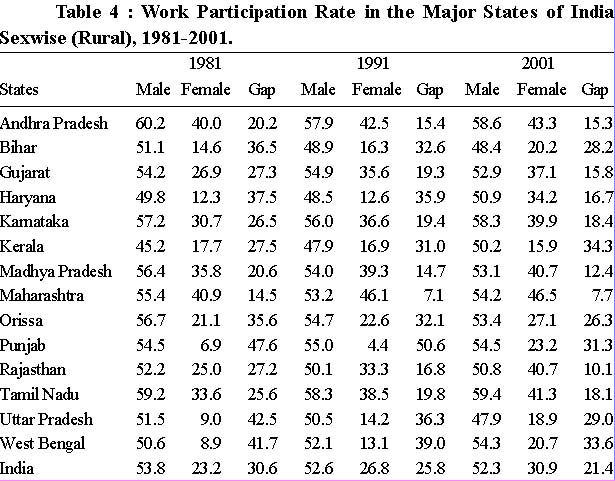 |
Participation rate in economic activity is low in urban areas as compared to the rural areas in all major states. With regard to the share of males and females in the labour force, it is seen that the highest rate was obtained in the state of Tamil Nadu in 1991 and 2001. It has the maximum value for all the periods in the case of females. The least participation rate for males was obtained in the urban areas of Kerala in 1981, while the state has improved its position by 1991 and again by increasing the rate in 2001.
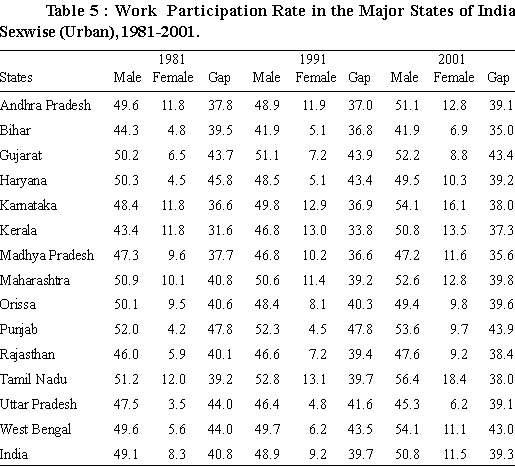 |
Female participation rate was always least in the urban areas of Uttar Pradesh. If we consider the gap between male and female rates in the urban areas, the maximum value was obtained in the state of Panjab, where the female participation rate was very poor, while that of males was higher. The male-female gap has been declining in almost all the states except in the southern states of Kerala, Karnataka, Tamil Nadu and Andhra Pradesh, where the gap has been continuously increasing from 1951 to 2001. In the urban areas the gap was highest in Kerala, while in the rural areas, the male-female gap in the work participation was least in this state. This is an interesting result. And so a detailed study of participation rate in Kerala is given in the following section.
Changes in the labour force participation in Kerala
The low level of female work participation rate in Kerala indicates the existence of a large proportion of unemployed women in the labour force. According to an estimate made by the Department of Economics and Statistics of the Government of Kerala, nearly 60 percent of the female labour force in Kerala remains unemployed. The pace of social development has far exceeded that of economic growth, leading to a paradoxical situation. On the one hand, it has encouraged women to participate in economic activities. On the other hand, structural changes in the economy have put severe constraints on the prospects of female employment at the higher levels and lead to a process of casualisation of the female labour force. This process of casualisation has been more severe in the case of women than men because of their limited mobility. The available secondary data on employment and unemployment suggests that the pattern of female employment in Kerala is different from the all India pattern.
The long-term trend in work participation rates has been declining in Kerala for both the sexes. And the female work participation rates have remained lower than male participation rates for the entire period, which is shown in table 6
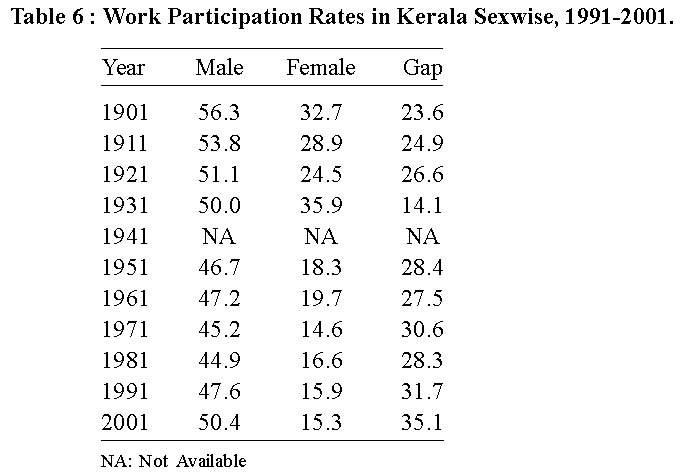 |
According to the 2001 census, total workers in Kerala was 10.3 million which comprises 7.8 million males and 2.5 million female workers. It is higher than that in the previous years. Female participation rate was always declining, from period to period and shows a 17.4 point decline from 1901 to 2001, but the corresponding decline in the male rate is only 5.9 point. The male participation rate shows an increasing trend during 1971 to 2001 period. But the female participation rate is below half that rate in 1901. The gap is maximum in 2001, and was least 1931.
A clear cut rural-urban difference in work participation rate of males and females was obtained in Kerala as evident from table 7.
 |
The work participation rate was always high in the rural areas except in the year 2001, where both rural and urban rates are almost same. The rural males of Kerala consisted of 50.2 percent workers in 2001, against a rate of 47.4 percent in 1961. These figures for males in the years 1961 and 2001 were 20.9 percent and 15.9 percent respectively. The urban population consisted of 45.9 percent of working males in 1961 and it increased to 50.8 percent of males working in 2001. The female participation rate was also slightly increased during this period. The gap of male-female rates was more or less high in the urban areas. Dissimilarity index also support this result. The high index shown by the urban areas indicates the very high inequality of females in the work participation with males compared to rural areas. This is because the female participation rate in the urban areas was very low and almost at the same level from the beginning of this century to the end. But in the case of rural females, the participation rate shows a decline of 5 points during this period. Therefore the decline in the total participation rate of females during the period was contributed by the rural folk. And as a whole the very low level participation of females in the urban areas has to be improved to fill the male-female gap in this area. Analysis of the sector-wise participation rate will give a clear idea about the present problem.
The primary sector of Kerala is different from that of the other states of India. The major part of the areas under the cash crops in India falls in Kerala. Kerala has got only a few industries. Even some of the traditional industries of Kerala such as cashew processing and coir making have not been running in a desirable manner and deriving profit, despite our attempts to make them profitable.
Industrial distribution of women workers in Kerala, from 1961 to 2001 (Table 8) showed that compared with male workers a large percentage of working females are agricultural labourers. They predominate both in the rural and urban areas of Kerala. Workers classified as cultivators and agricultural labourers are taken here as primary and others as non-primary workers. The sectoral distribution of the workforce in Kerala is found to be significantly different from the all India pattern. In 2001 the primary sector accounted for 26.7 percent of female workers as against 22.2 percent of male workers, and female participation rate was always high during the entire period. During 1961-2001, the share of the primary sector in female employment showed a 16.9 point decline and the corresponding decline in the male rate was only 13.9 percent. While the primary sector still remains the largest source of employment for both men and women in India, in Kerala not even half the work force is employed in the primary sector. The proportion of female agricultural labourers declined from 1981 to 2001 perhaps due to the fall in the area under rice cultivation.
Female participation rate is higher than that of males in the primary sector, both in rural and urban areas. In the rural areas, the percentage of male and female workers in the primary sector increased from 1961 to 1971 and both the rates showed a 26 point decline from 1971 to 2001. In the case of urban areas, male participation rate in the primary sector was very low. The female rates had steadily declined from 21.9 percent in 1991 to 9.8 percent in 2001, in the urban areas. This may be due to the weaning away of female agricultural labourers to schemes such as IRDP, and a fall in the cultivable land due to a large increase in the construction of houses and buildings in the last decade.
 |
More than half of the male and female workers in Kerala are in the non-primary sector. Their share increased from 1971 to 1991 very sharply, and there is a large and sudden rise in the rate in 2001 in all areas. Above 90 percent of male workers in the urban areas are in the non-primary sector from 1961 to 2001, except in the year 1991. The non-primary sector accounts for 84.6 percent of working women in 1961 and the rate increased to 90.2 percent in 2001 period.
Considering the primary and non-primary sector of labour force in Kerala separately, the gap between the male and female rates becomes less when compared to that of total workers. The low level participation of females in the non-primary sector contribute to the low level of female participation in the urban areas. The loss of chance in the agricultural sector due to the scarcity of cultivable land and less advancement in the non-primary sector to give opportunities in the urban areas may be the reasons for the low level of female participation in Kerala. Even though in Kerala, females are not at par with males in work participation, the urban women enjoy very high position when compared to the other states of India. The slow growth rate in the primary and secondary sectors does not create adequate employment opportunities for females in Kerala. And therefore planners should give emphasis on this area to uplift the status of Kerala women.
Suggestions for enhancing the female work participation rate
• Technical and job-oriented education should be given to women in all states of India.
• Development policies should be oriented to fulfill the needs of all sections of women both in rural and urban areas.
• More opportunities should be developed in the secondary and tertiary sectors of employment in the urban areas.
• Industrial development should take place in the rural areas also, through which rural women will get more chances.
• Child care facilities should be made more efficient by providing child care centres at work places so that women who want to go out for work would not be worried by child care responsibilities.
• Speed up the growth of employment opportunities in the tertiary sectors in the urban areas.
• provide new technologies to strengthen the primary sector in rural areas to increase participation of females.
• Government should attract persons or bodies who are ready for capital investment to create female employment opportunities.
REFERENCES
Asha A. Bhende. (1985), Principles of Population Studies, Himalaya Publishing House, New Delhi .
Sumathi Kulkarni. (1981), ‘Economic aspects of population’ in Teaching and Research in Population Studies ed. G. Rama Rao, Asha Bende and Tara Kanitkar.
Thara Bhai, L. (2000), Women’s Studies in India, A.P.H Publishing corporation, New Delhi.
United Nations. (1976), The methods and materials in Demography.
G.K.MOLI. Is a population information officer, Dept.of Demography, University of Kerala.
lLABOUR FORCE IN INDIA:
THE GENDER GAP
G.K. MOLI
Abstract: The paper attempts to study the changes in the labour force in India during the last few decades. The participation of women in economic activity in rural and urban areas is also subjected to analysis. The paper concludes with suggestions for enhancing women’s work participation rate.
Keywords: Manpower and Female Workforce, Male/Female work participation, Industrial distribution of women workers, Primary/ Non-primary Sector, Socio-Economic Development
The manpower of a nation is the totality of persons who could produce the goods and services if there were a demand for their labours and they desired to participate in such activity. The economically active population, sometimes also called the working force, is that part of the manpower which actually engages, or attempts to engage, in the production of economic goods and services (UN, 1976).
An important economic characteristic of the population of a country is the size and quality of its work force. The number and quality of work and regularity of employment of the economically active population determine the economic and social development attained by that nation. In other words, the important aspect of the structure of economy is closely related to the level of the country’s economic development and productive efficiency.
The economic and social development of a nation depends on the number of persons who are economically active and the quality of their work. Labour force participation rates are useful for an understanding of the extent to which women, children and the aged participate in economic activity. Several questions can be answered through an analysis of labour force statistics from the point of view of social welfare. And such studies provide the base on which national plans for social and economic development may be formulated and are therefore, considered important for policy makers and planners (Asha. A. Bhende, 1985).
The importance of the labour force is obvious, especially for developing countries where unemployment is a major problem. As economic development and industrialization advance, it is generally expected that there is more scope for specialization and division of labour. Along with the study of general trends regarding labour force participation, the study of the economic activity of certain sections of the population also receives attention. Economic activity of females and of children is a subject of special importance for most of the developing agricultural countries like India (Sumathi Kulkarni, 1981).
Labour force participation of women
Women’s work outside the home has become a necessity for society as well as for women. Most families prefer the woman to work so that family’s class status will go up which in the long run carves a unique niche for that particular family in the society. In developing countries like India where traditions are deep rooted in various aspects of life, employment for women is considered only as a peripheral phenomenon. The main duty of the woman is still wifing and mothering. Studies in India reveal that women’s roles are still in the fold of tradition as society expects women to be more familial and not societal. Men are considered as societal and therefore there is no concept of ‘house-husband’ whereas women, a familial category, is never societal or society never permits her to be in the main stream. As long as this distinction stays in the society, woman will mainly be a house wife (Thara Bahi, 2000).
Though scientists in the field always mention the woman in the Indian context or Indian perspective, they never distinguished her in general and specific terms. A number of studies on women’s issues were conducted in the last three decades and analysis of these works proves that there are innumerable categories of women in India. To make it more clear, issue specific analysis are related to the various groups of women in different ways. In the first place, or issues like education and occupation, rural and urban women show sharp contrast. Our rural women are not the same as urban women, as rural culture and rural society may be at times contradictory to each other.
In most countries women represent that component of the labour force whose participation is the most sensitive to economic as well as social development. Wide differences are noticed in the industrial sector of female labour between countries and even within countries, according to the nature of economic development of the economy. In most developing countries the majority of women are found working in the agricultural sector with more females in the tertiary sector compared to secondary sector.
This paper is an attempt to understand the changes in the participation in economic activity by women in the major states of India and a specific analysis is made for Kerala also. Stress is given to study the sex pattern of participation in economic activity separately for rural and urban areas during the last three decades. Inequality between the sexes gets special attention in this paper. The given rate of economic activity other than that of cultivators and agricultural labourers in Kerala, is also analysed for rural and urban areas.
The study is based on the census data on the size and industrial distribution of working force. Data on workers in the major states of India are taken from various census reports of 1961 to 2001. Comparison of workers in different census periods became a problem due to variations in the concept and definition of workers in each census during 1981-2001 period. Main and marginal workers are taken together as workforce for the purpose of this study.
The most common measure of labour force, the crude activity rate, is used to make comparison. The crude activity rate is the percentage of persons economically active to the total population. The variations in definitions and operational procedures that most often affect measures of economic activity have their greatest impact on figures for women, because women’s attachment to the labour force is often marginal and intermittent. For men, the rates are less subject to temporary or spurious variation than rates for women and comparison of rates for men are valued (United Nations, 1976). The male-female difference in the participation is calculated to find the gap between the two sexes. The dissimilarity index is also used in certain places to find the equality between male and female activity rates, which is calculated using the formula,
 |
Labour force in India
The pattern of employment distribution of Indian workers is one of marked concentration in agriculture with a considerably smaller fraction involved in industry. Since labour force participation rates tend, typically, to be lower for both males and females in urban areas than in rural areas, the historical impact of urbanization on crude activity rates has been negative. The failure of structural change in employment to accompany urbanization can be traced to the fact that the growth of modern industry in towns and cities dealt a blow to the rural household industry. With changing technology and scale of production there was a shift in the location of industry from rural to urban centres, specially large metropolitan cities. These changes were unfavourable to women’s participation in work.
According to the report of the committee on the status of women in India (1974) the number of female employees in the categories of professional, technical and related work and primary and middle school teachers has been continuously rising since 1960. In post independence India we had a series of laws passed for the upliftment of women. The constitutional recognition of equal status for women and progressive enactments have undoubtedly empowered Indian women with judicial equality. But the principles of equality enshrined in the constitution of India are far from reality.
Today the situation has changed and there are remarkable changes in the attitude of women, particularly employed, towards the natural superiority of men. Many girls are getting opportunities of entering the portals of higher education and they are working in non-traditional jobs like men. Even though women workers have increasingly taken to industrial work, both skilled and semi-skilled, their participation in the productive pursuits of the country is very low, when compared to men. Another noteworthy feature is that there has been a general decline in the proportion of female working population to total female population.
The female labour force participation rate in India is not only low, but also has remained near stagnant over the past several decades. Moreover, there still exists a large difference between the work participation rates of males and females, which is an important aspect of gender inequality. The data on work force provided in the reports of the successive rounds of National Sample Survey (NSS) clearly point out the trend of increasing casualisation of the workforce, the incidence of which is more severe among women than among men. The trend in the participation rate obtained from census data consequently differed between sexes as is evident from the following Table1
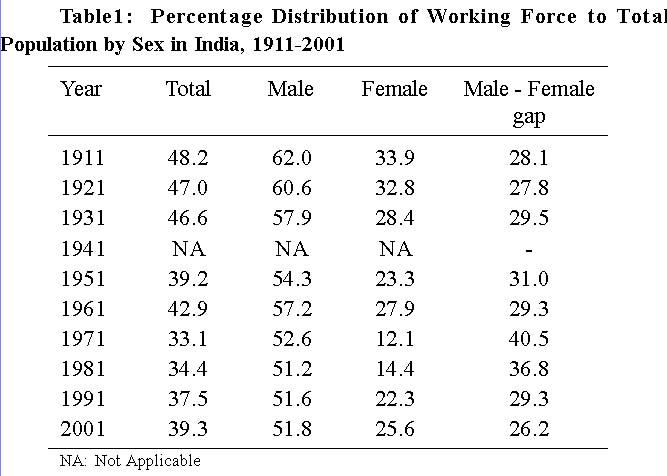 |
It can be observed from the data in Table 1 that the percentage of working population to total population has been gradually on the decline both among males and females during the last ninety years. There were 180.4 million workers constituting nearly 33.1 percent of the total population in 1971 which increased to 34.4 percent in 1981. According to 2001 census, about 39.3 percent of the population of the country are engaged in some economic activity. This is an increase of about 1.8 percentage points over the corresponding figure as per the 1991 census. Thus the share of workers in India has increased by less than 2 percent during 1991-2001. This increase in the share of workers has brought down the economic dependency ratio in India.
Women working population came down from 33.9 percent in 1911 to 23.3 percent in 1951. After 1951, it rose to 27.9 in 1961 and slumped to 12.1 percent in 1971 and 14.4 percent in 1981. And in 1991, the work participation rate of females steadily rose to 22.3 percent and again shows an increase to 25.6 percent in 2001 census. This is only less than half of that of the percentage of males in the same period. Anyway it is a fact that women workers always formed a small proportion of the population.
The percentage of male working population to total population was 57.2 in 1961. It has come down to 52.6 in 1971 and 51.2 in 1981. The rate is almost the same in 1991 and 2001 with a slight increase in each year. The share of males among the workers has been reducing in the country since 1971 while the female share is on the rise. In 1971, 80.3 percent of the working population was males while in 1991 this was only 71.3 percent. Thus the female share of workers has increased by about 9 percentage points during this period, and again an increase of 9 percentage from 1991 to 2001.
The country has 2.5 male workers for every female worker as per the 1991 census and it reduced to 2.2 male workers for one female worker as per 2001 census. This is almost same as in the position of 1961 when the ratio was only 2.2, the ratio has been coming down as compared to the position of 1971. Thus the gap between the shares of male and female workers has reduced considerably between 1971 and 1991. the maximum gap in the male-female rates was seen in the year 1971 where it was 40.5 percent and it was least in 2001 census. All of these observations show that the difference in the male-female participation rates narrowed and so female work force increased from the period of 1971 to 2001. Rural – Urban Share of Workers
Studies of the rural Indian female participation rates and its variation in the states of India found that the rate of economic activity was high in the rural areas when compared to the urban areas. Work participation rate in the rural and urban areas of males and females in India is given in Table 2.
About 40 percent of the population of rural areas in the country were in the labour force in 1991. This share has increased regularly both in rural and urban areas since 1971. Compared to the rates in 1981, the increase is only marginal. As per 2001 census about 42 percent of the rural population and 32 percent of the urban population are workers. In both areas the increase is by 2 percentage points over the position of 1991. The gap between the shares of male and female workers has also narrowed down during 1971-2001 period. And this gap is very high in the urban areas and it remains almost in the same position from 1971 to 2001. But the gap in rural areas become narrowed and reached the level below that of the total population in 2001.
 |
In 1991, the country had about 2.5 male workers per female worker while in the rural and urban areas the values were 2.1 and 6.0 respectively. They have come down to 2.2, 1.8 and 4.9 respectively in 2001. Therefore the gap in the male-female participation rates in India is due to the wide gap that existed in the urban areas. Inequality between the male and female participation rates can be reduced only by reducing the male-female gap in urban areas or by increasing the participation of urban females.
Economic Activity in the Indian States
The work participation rates of both men and women declined during the decades from 1901 to 1971, in all the states. The trends have however, reversed to some extent since 1971. The share of males among the workers has been reducing in the states since 1971 while the female share is on the rise, after 1971. The 1971 census does not give the break-up for main workers and marginal workers. Hence in order to present comparable data, the following tables (Tables 3, 4 and 5) give the percentage of workers from 1981 to 2001 for the major Indian states. A uniform pattern of decline in female work participation rate was obtained in the states during the period. Considerable variations are seen between the states with regard to their economic activities in the 1981-2001 period.
Table 3 gives the percentage of workers for census years of 1981 to 2001, for the major states of India. Female work participation rate was highest in the state of Andhra Pradesh during the entire period. And the lowest female participation rate was in Punjab in 1981 and 1991 and it was in Kerala in 2001. Male participation rate also was lowest in Kerala in 1981 and 1991. The highest male participation rate was seen in the state of Tamil Nadu in 1991 and 2001. It was so Andhra Pradesh in 1981.
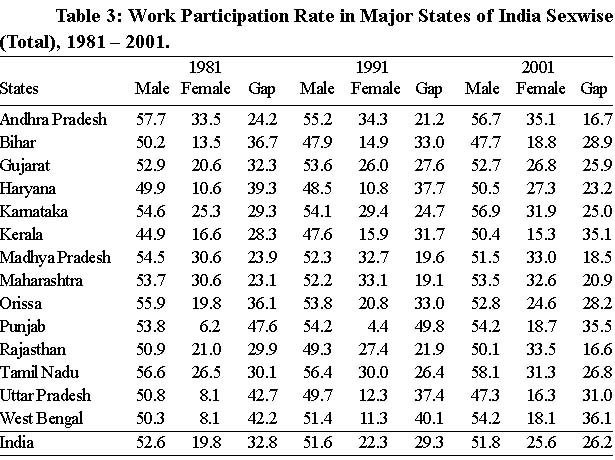 |
The male-female gap in rates gives a different picture. The gap is lowest in the state of Maharashtra and highest in Punjab according to 1981 and 1991 census. In 2001 the male-female difference in work participation was lowest in Rajasthan, where the female participation rate has steadily increased from 1991 to 2001. And the highest gap was noticed in West Bengal in 2001. The gap in male-female participation rates shows a declining trend from year to year in most of the states. Two states namely Karnataka and Maharashtra have an increase in the male-female gap during 1991-2001 period. Kerala is the only state where the gap was constantly increasing from 1981, and attained almost the highest level in 2001. In terms of Human Development Index, Kerala ranks first among Indian states and has the second lowest gender disparity also. But the development of women in economic activity is not at par with this situation.
Work participation rate in the rural areas of Indian states is presented in Table 4. In the case of male participation, the maximum rate was obtained in the rural areas of Andhra Pradesh in 1981, and in 1991 and 2001, this is in Tamil Nadu. The lowest male participation rate was always obtained in the rural areas of Kerala. In the case of female participation rate, the rural areas of Maharashtra is in the highest position and it was lowest in Punjab in 1981 and 1991. Kerala has the lowest female participation rate in rural areas also according to 2001 census and so attained the highest male-female gap. The lowest gap in male-female rate was obtained in Maharashtra where the female participation rate is highest among the states in all the periods considered. This gap is always declining from year to year in almost all the states. The exceptions are Kerala and Punjab. In Punjab the gap increased in 1981-91 period and then showed a decline in 2001. But in the case of Kerala, the male-female difference is increasing from period to period in the rural areas. And so the equality of rural females became less and less in the economic activity.
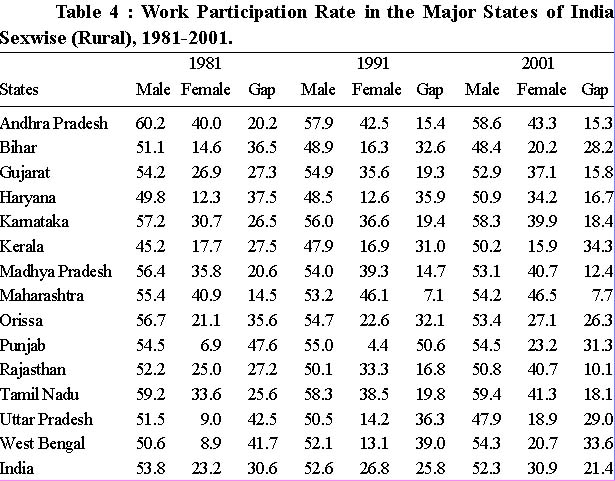 |
Participation rate in economic activity is low in urban areas as compared to the rural areas in all major states. With regard to the share of males and females in the labour force, it is seen that the highest rate was obtained in the state of Tamil Nadu in 1991 and 2001. It has the maximum value for all the periods in the case of females. The least participation rate for males was obtained in the urban areas of Kerala in 1981, while the state has improved its position by 1991 and again by increasing the rate in 2001.
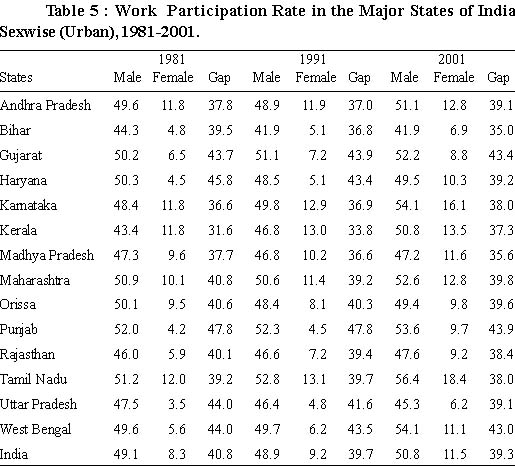 |
Female participation rate was always least in the urban areas of Uttar Pradesh. If we consider the gap between male and female rates in the urban areas, the maximum value was obtained in the state of Panjab, where the female participation rate was very poor, while that of males was higher. The male-female gap has been declining in almost all the states except in the southern states of Kerala, Karnataka, Tamil Nadu and Andhra Pradesh, where the gap has been continuously increasing from 1951 to 2001. In the urban areas the gap was highest in Kerala, while in the rural areas, the male-female gap in the work participation was least in this state. This is an interesting result. And so a detailed study of participation rate in Kerala is given in the following section.
Changes in the labour force participation in Kerala
The low level of female work participation rate in Kerala indicates the existence of a large proportion of unemployed women in the labour force. According to an estimate made by the Department of Economics and Statistics of the Government of Kerala, nearly 60 percent of the female labour force in Kerala remains unemployed. The pace of social development has far exceeded that of economic growth, leading to a paradoxical situation. On the one hand, it has encouraged women to participate in economic activities. On the other hand, structural changes in the economy have put severe constraints on the prospects of female employment at the higher levels and lead to a process of casualisation of the female labour force. This process of casualisation has been more severe in the case of women than men because of their limited mobility. The available secondary data on employment and unemployment suggests that the pattern of female employment in Kerala is different from the all India pattern.
The long-term trend in work participation rates has been declining in Kerala for both the sexes. And the female work participation rates have remained lower than male participation rates for the entire period, which is shown in table 6
 |
According to the 2001 census, total workers in Kerala was 10.3 million which comprises 7.8 million males and 2.5 million female workers. It is higher than that in the previous years. Female participation rate was always declining, from period to period and shows a 17.4 point decline from 1901 to 2001, but the corresponding decline in the male rate is only 5.9 point. The male participation rate shows an increasing trend during 1971 to 2001 period. But the female participation rate is below half that rate in 1901. The gap is maximum in 2001, and was least 1931.
A clear cut rural-urban difference in work participation rate of males and females was obtained in Kerala as evident from table 7.
 |
The work participation rate was always high in the rural areas except in the year 2001, where both rural and urban rates are almost same. The rural males of Kerala consisted of 50.2 percent workers in 2001, against a rate of 47.4 percent in 1961. These figures for males in the years 1961 and 2001 were 20.9 percent and 15.9 percent respectively. The urban population consisted of 45.9 percent of working males in 1961 and it increased to 50.8 percent of males working in 2001. The female participation rate was also slightly increased during this period. The gap of male-female rates was more or less high in the urban areas. Dissimilarity index also support this result. The high index shown by the urban areas indicates the very high inequality of females in the work participation with males compared to rural areas. This is because the female participation rate in the urban areas was very low and almost at the same level from the beginning of this century to the end. But in the case of rural females, the participation rate shows a decline of 5 points during this period. Therefore the decline in the total participation rate of females during the period was contributed by the rural folk. And as a whole the very low level participation of females in the urban areas has to be improved to fill the male-female gap in this area. Analysis of the sector-wise participation rate will give a clear idea about the present problem.
The primary sector of Kerala is different from that of the other states of India. The major part of the areas under the cash crops in India falls in Kerala. Kerala has got only a few industries. Even some of the traditional industries of Kerala such as cashew processing and coir making have not been running in a desirable manner and deriving profit, despite our attempts to make them profitable.
Industrial distribution of women workers in Kerala, from 1961 to 2001 (Table 8) showed that compared with male workers a large percentage of working females are agricultural labourers. They predominate both in the rural and urban areas of Kerala. Workers classified as cultivators and agricultural labourers are taken here as primary and others as non-primary workers. The sectoral distribution of the workforce in Kerala is found to be significantly different from the all India pattern. In 2001 the primary sector accounted for 26.7 percent of female workers as against 22.2 percent of male workers, and female participation rate was always high during the entire period. During 1961-2001, the share of the primary sector in female employment showed a 16.9 point decline and the corresponding decline in the male rate was only 13.9 percent. While the primary sector still remains the largest source of employment for both men and women in India, in Kerala not even half the work force is employed in the primary sector. The proportion of female agricultural labourers declined from 1981 to 2001 perhaps due to the fall in the area under rice cultivation.
Female participation rate is higher than that of males in the primary sector, both in rural and urban areas. In the rural areas, the percentage of male and female workers in the primary sector increased from 1961 to 1971 and both the rates showed a 26 point decline from 1971 to 2001. In the case of urban areas, male participation rate in the primary sector was very low. The female rates had steadily declined from 21.9 percent in 1991 to 9.8 percent in 2001, in the urban areas. This may be due to the weaning away of female agricultural labourers to schemes such as IRDP, and a fall in the cultivable land due to a large increase in the construction of houses and buildings in the last decade.
 |
More than half of the male and female workers in Kerala are in the non-primary sector. Their share increased from 1971 to 1991 very sharply, and there is a large and sudden rise in the rate in 2001 in all areas. Above 90 percent of male workers in the urban areas are in the non-primary sector from 1961 to 2001, except in the year 1991. The non-primary sector accounts for 84.6 percent of working women in 1961 and the rate increased to 90.2 percent in 2001 period.
Considering the primary and non-primary sector of labour force in Kerala separately, the gap between the male and female rates becomes less when compared to that of total workers. The low level participation of females in the non-primary sector contribute to the low level of female participation in the urban areas. The loss of chance in the agricultural sector due to the scarcity of cultivable land and less advancement in the non-primary sector to give opportunities in the urban areas may be the reasons for the low level of female participation in Kerala. Even though in Kerala, females are not at par with males in work participation, the urban women enjoy very high position when compared to the other states of India. The slow growth rate in the primary and secondary sectors does not create adequate employment opportunities for females in Kerala. And therefore planners should give emphasis on this area to uplift the status of Kerala women.
Suggestions for enhancing the female work participation rate
• Technical and job-oriented education should be given to women in all states of India.
• Development policies should be oriented to fulfill the needs of all sections of women both in rural and urban areas.
• More opportunities should be developed in the secondary and tertiary sectors of employment in the urban areas.
• Industrial development should take place in the rural areas also, through which rural women will get more chances.
• Child care facilities should be made more efficient by providing child care centres at work places so that women who want to go out for work would not be worried by child care responsibilities.
• Speed up the growth of employment opportunities in the tertiary sectors in the urban areas.
• provide new technologies to strengthen the primary sector in rural areas to increase participation of females.
• Government should attract persons or bodies who are ready for capital investment to create female employment opportunities.
REFERENCES
Asha A. Bhende. (1985), Principles of Population Studies, Himalaya Publishing House, New Delhi .
Sumathi Kulkarni. (1981), ‘Economic aspects of population’ in Teaching and Research in Population Studies ed. G. Rama Rao, Asha Bende and Tara Kanitkar.
Thara Bhai, L. (2000), Women’s Studies in India, A.P.H Publishing corporation, New Delhi.
United Nations. (1976), The methods and materials in Demography.
G.K.MOLI. Is a population information officer, Dept.of Demography, University of Kerala.

